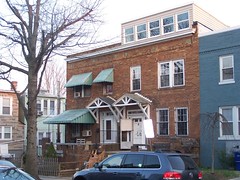1010 Irving Street NW with discordant third floor addition
It is because of abominations such as this that I favor city-wide design guidelines whether or not a neighborhood is designated as a historic district.
This building stock would be considered contributing structures as part of a designated historic district, but creating historic districts is difficult in these times of the rising property rights movement, selfishness, and the disconnect in understanding about what makes livable neighborhoods in center cities (history + urban design + architecture), why these qualities need to be preserved, and how to do so.
In DC law, only historic districts possess additional design review "privileges" when infill construction and/or substantive changes to extant properties are proposed.
That's why design, historicity, and architectural integrity tends to be more apparent in historic districts.




0 Comments:
Post a Comment
<< Home